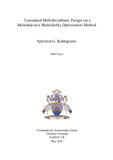JavaScript is disabled for your browser. Some features of this site may not work without it.
| dc.contributor.advisor | Savill, Mark A. | |
| dc.contributor.advisor | Kipouros, Timoleon | |
| dc.contributor.author | Kontogianis, Spyridon G. | |
| dc.date.accessioned | 2023-02-15T09:56:07Z | |
| dc.date.available | 2023-02-15T09:56:07Z | |
| dc.date.issued | 2018-05 | |
| dc.identifier.uri | https://dspace.lib.cranfield.ac.uk/handle/1826/19185 | |
| dc.description.abstract | Air travel demand and the associated fuel emissions are expected to keep increasing in the following decades, forcing the aerospace industry to find ways to revolutionise the design process to achieve step-like performance improvements and emission reduction goals. A promising approach towards that goal is multidisciplinary design. To maximise the benefits, interdisciplinary synergies have to be investigated early in the design process. Efficient multidisciplinary optimisation tools are required to reliably identify a set of promising design directions to support engineering decision making towards the new generation of aircraft. To support these needs, a novel optimisation methodology is proposed aiming in exploiting multidisciplinary trends in the conceptual stage, exploring the design space and providing a pareto set of optimum configurations in the minimum cost possible. This is achieved by a combination of the expected improvement surrogate based optimisation plan, a novel Kriging modification to allow the use of multi-fidelity tools and a multi-objective sub-optimisation process infill formulation implemented within an multidisciplinary design optimisation architecture. A series of analytical test cases were initially used to develop the methodology and examine its performance under a set of criteria like global optimality, computational efficiency and dimensionality scaling. These were followed by two industrially relevant aerodynamic design cases, the RAE2822 transonic airfoil and the GARTEUR high lift configuration, investigating the effect of the constraint handling methods and the low fidelity tool. The cost reductions and exploration characteristics achieved by the method were quantified in realistic unconstrained, constrained and multi-objective problems. Finally, an aerostructural optimisation study of the NASA Common Research Model was used as a representative of a complex multidisciplinary design problem. The results demonstrate the framework’s capabilities in industrial problems, showing improved results and design space exploration but with lower costs than similarly oriented methods. The effect of the multidisciplinary architecture was also examined. | en_UK |
| dc.language.iso | en | en_UK |
| dc.rights | © Cranfield University, 2015. All rights reserved. No part of this publication may be reproduced without the written permission of the copyright holder. | |
| dc.subject | RAE2822 transonic airfoil | en_UK |
| dc.subject | GARTEUR high lift configuration | en_UK |
| dc.subject | multidisciplinary design | en_UK |
| dc.subject | interdisciplinary synergies | en_UK |
| dc.subject | Kriging modification | en_UK |
| dc.subject | multidisciplinary design optimisation architecture | en_UK |
| dc.title | Conceptual multidisciplinary design via a multi-objective multi-fidelity optimisation method. | en_UK |
| dc.type | Thesis | en_UK |
